Oracle Analytics Cloud – The BI & Analytics Survey 24 Summary

Carrying on with the theme from our blog on Forrester Wave BI Q2 2023 report for Oracle Analytics Cloud, here is a summary of the BI & Analytics Survey 24 wherein Oracle Analytics Cloud has yet again proven its mettle.
BARC is one of Europe’s leading analyst firms focusing on areas of Data, BI and Analytics and the latest 2024 BARC scores validating the benefits of product modernisation and continuous development hold great significance. The BI & Analytics Survey 24 report on Oracle Analytics Cloud is the result of the largest and most comprehensive survey of business intelligence and analytics software users, conducted between March and June 2023 collecting responses from around 1500 participants.
Can’t stress enough, the importance of actively listening to and valuing the feedback of customers and communities when it comes to improving products, services, and overall customer experiences. With Oracle Analytics focusing on just that over the years, it is not surprising to see how Oracle Analytics Cloud has made its strong presence felt by the ‘Top rank’ and ‘Leader’ level triumphs in the evaluated KPIs.
Interestingly, the peer group classification is based on the key factors: 1. Focus 2. Specialisation 3. Usage Scenario 4. Global Presence. Oracle Analytics Cloud is featured in the peer groups listed below:
• Large/Enterprise-Wide Implementations: Products typically used in large scenarios and/or enterprise-wide implementations with large numbers of users and data volumes.
• International BI Giants: Products from companies with annual revenues of $400m+ and a truly international reach in terms of partner ecosystem, on-site locations, global installations, and revenues.
• Embedded Analytics Focus: Includes reporting and analytics products that support open standards for embedding in other business applications and are used by a significant number of clients.
• Report & Dashboard Focus: Mainly around products that focus on the creation and distribution of standardised and governed content like dashboards and reports.
• Analysis Focus: Includes products focusing on ad hoc query, data navigation and analysis.
• Business Software Generalists: Have a broad product portfolio that is not limited to BI and Analytics, including most (or all) types of enterprise software for a variety of business requirements like ERP.
Oracle Analytics Cloud Highlights
Let us take a look at some of the outstanding KPI highlights of Oracle Analytics Cloud in the BI & Analytic Survey 24 wherein the top-ranking and leader level is secured.
- Advanced & Predictive Analytics
Oracle Analytics customers have rated the advanced and predictive analytics functionality above all the products featured in The BI & Analytics Survey 24.
OAC has bagged the top rank in all 6 peer groups for Advanced & Predictive Analytics KPI. This KPI is based on how many survey respondents use advanced and predictive analysis (such as data mining/machine learning) with their BI tool and how users rate those capabilities.
According to BARC, what sets OAC apart is the fact that compared to customers using Advanced & predictive analytics from other vendors who have shown fragmented adoption - mainly conducting proof of concepts and pilot projects and not made big progress concerning operationalising analytics algorithms due to challenges encountered; OAC customers were found to be very much engaged. It is the second consecutive year that Oracle has bagged top rank in this KPI.
“45 per cent of Oracle Analytics Cloud users have already made use of the suite’s advanced and predictive functionality, demonstrating a strong commitment to harnessing the potential of advanced analytics within their organisations”.
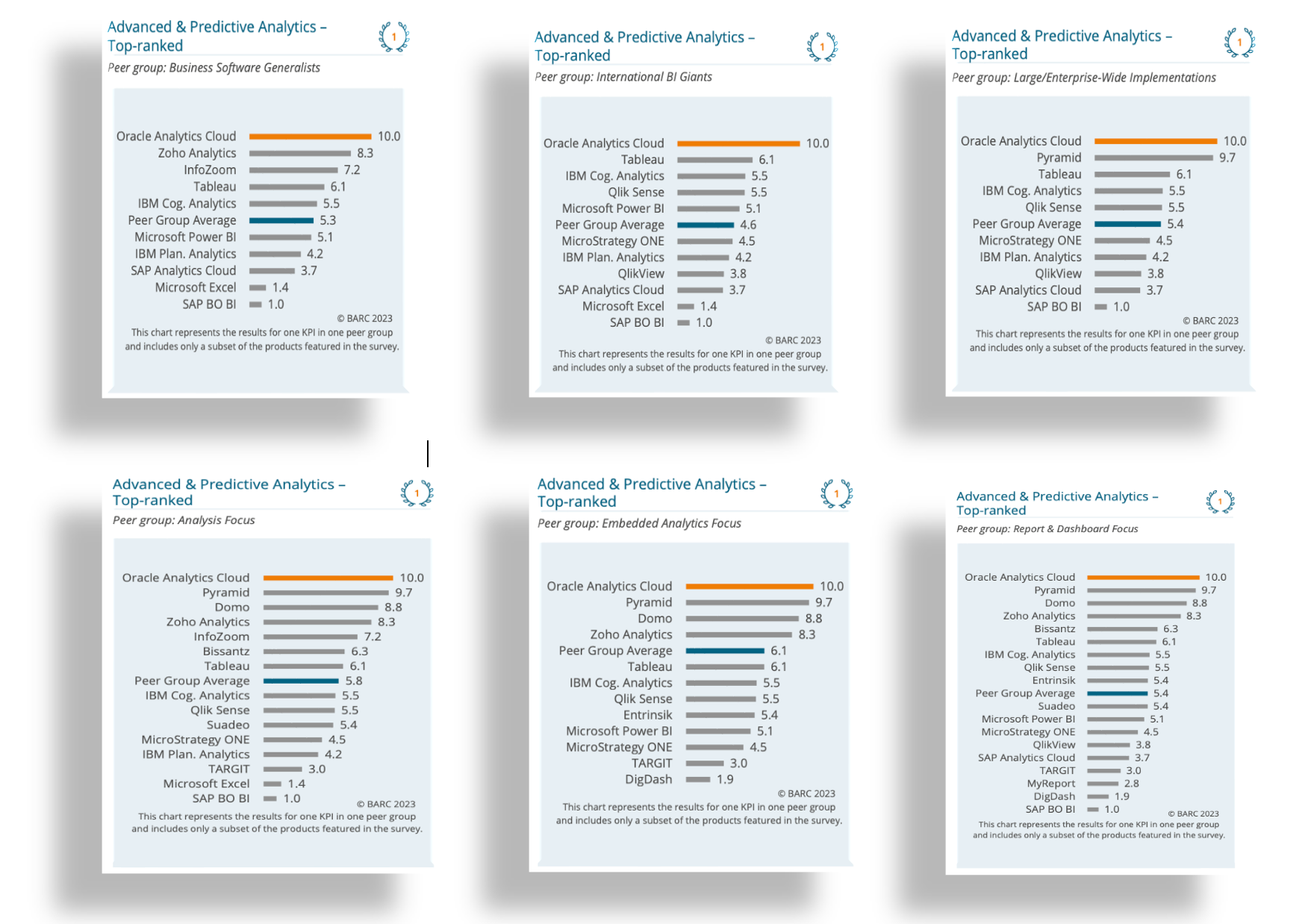
- Flexibility
This KPI is based on how users rate the BI tool’s flexibility and on the frequency of complaints about user flexibility post-implementation. Amazing to see Oracle Analytics Cloud has maintained the position as a Leader in all 6 peer groups.
89% of surveyed users have rated OAC’s flexibility in areas of data modelling and connectivity as excellent or good, compared to 64% for the average BI & analytics tool.
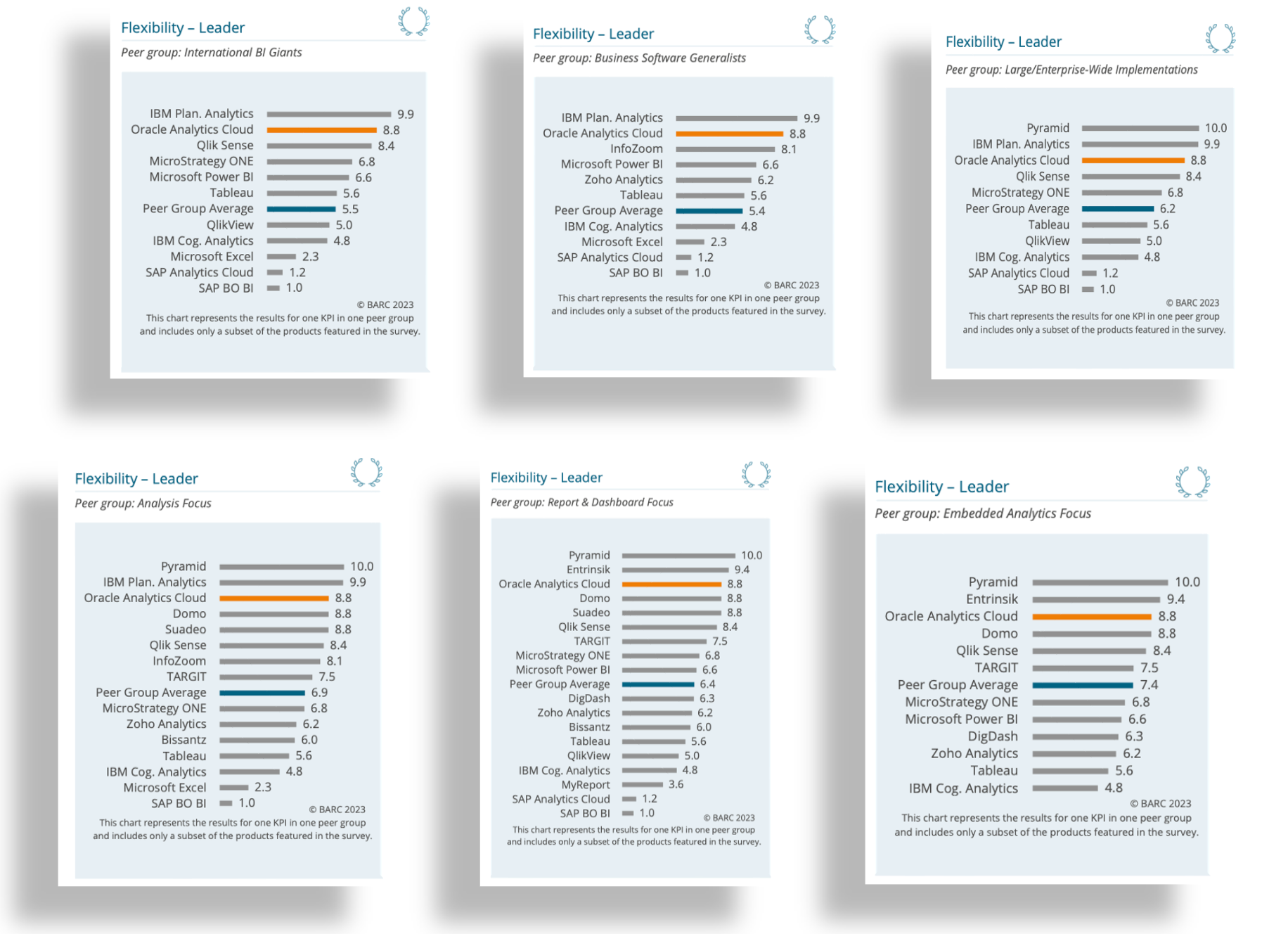
- Price-to-Value
One of the most important KPIs when it comes to user adoption. Based on the survey results, OAC is Top-ranked in the Price-to-value KPI under the peer groups – Business Software Generalists, International BI Giants and Large/ Enterprise-Wide Implementations. For the rest of the peer groups, OAC has maintained an impressive Leader ranking.
It is exciting to see the BARC viewpoint that out of the surveyed OAC users, 45% were persuaded by the product’s versatility and another 45% by the availability of people skilled at using it. An impressive 89% even rated its price-to-value as “excellent” or “good”, compared to 73% for the average BI & analytics tool.
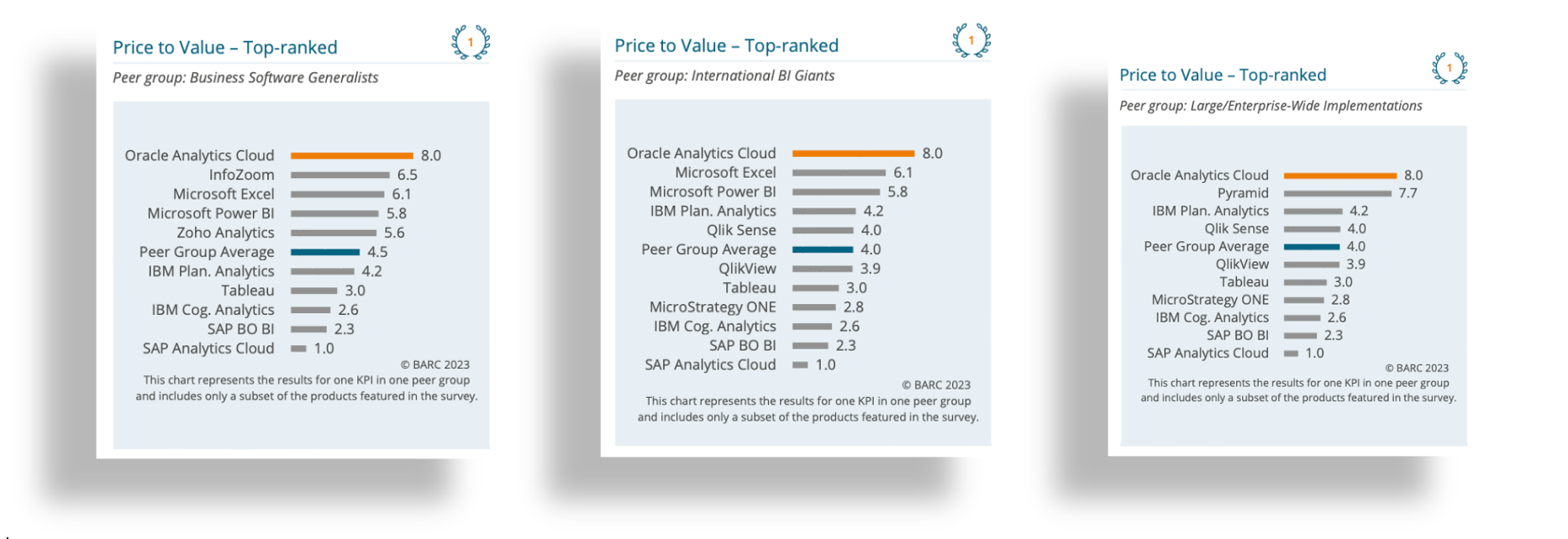
Vendor Support
When it comes to the KPI measuring user satisfaction with the level of vendor support provided for the product, OAC is top-positioned compared to other International BI giants by a significant margin. Impressively, OAC has secured a position as a Leader under Business Software Generalists and Large/ Enterprise-Wide Implementations groups.
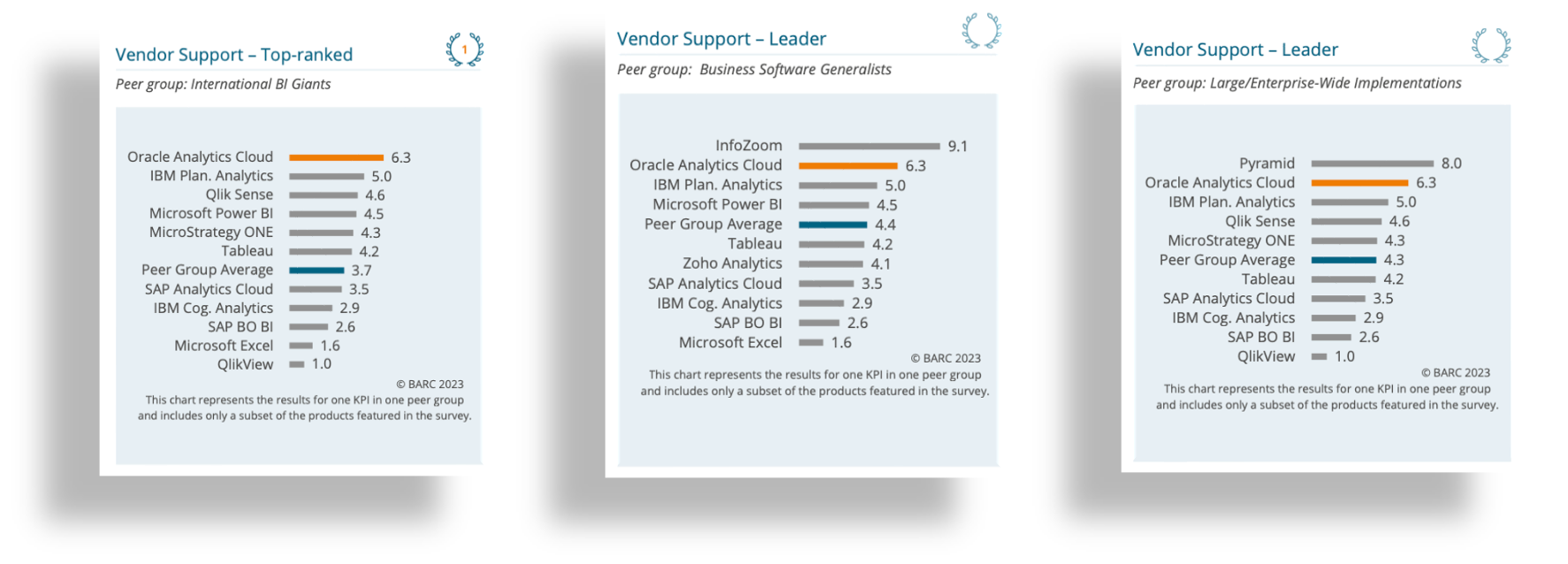
- Embedded BI
About the adoption of embedded analytics, OAC is the second highest-rated vendor for the second year in a row. OAC has bagged the top position under the peer groups - International BI Giants and Business Software Generalists. Once again, OAC is a Leader in the rest of the Peer Groups.
According to BARC, “64 per cent of Oracle Analytics users work with the software embedded in other systems and a further 27 per cent plan to do so. Together with its high level of use in operational BI, this achievement shows that a good portion of those who have taken advantage of Oracle’s predefined content for its business software – such as Fusion Analytics and NetSuite Analytics – responded to our survey”.
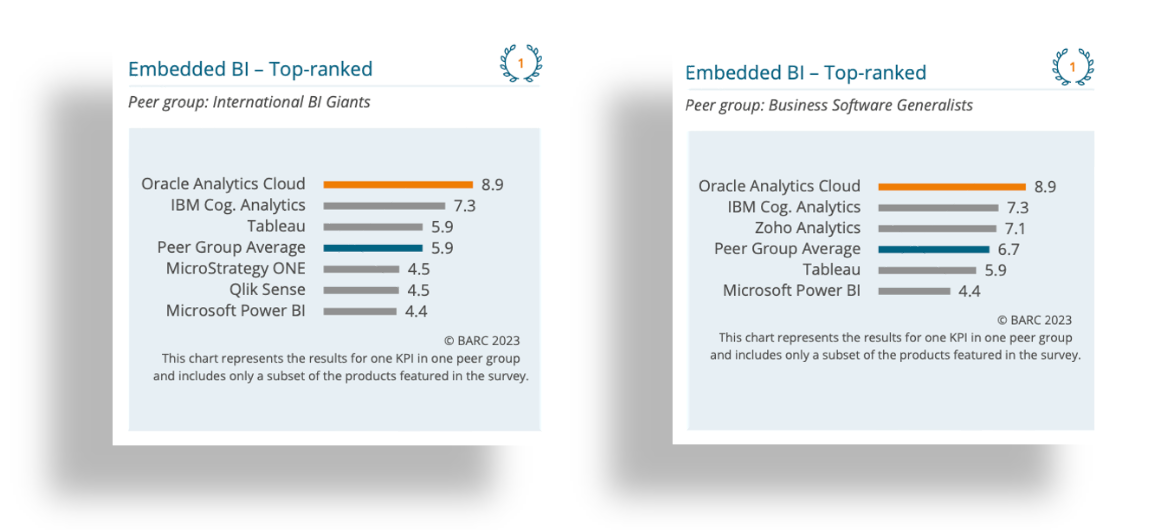
- Functionality
An important KPI combining the Dashboards & Reports, Distribution of Reports, Analyses & Ad Hoc Query, Advanced & Predictive Analytics, Data Preparation and Mobile BI KPIs. Wonderful to see OAC reigning with a top rank under International BI Giants and Business Software Generalists peer groups and as a Leader under Large/ Enterprise-Wide Implementation groups.
BARC reports that 45% of respondents have quoted the most prevalent reason for adopting Oracle Analytics Cloud as its extensive coverage of BI or Analytics-specific requirements and have found the suite to be versatile and functional. Compared to the overall survey average of 31%, the BARC survey marks this percentage as significantly higher.
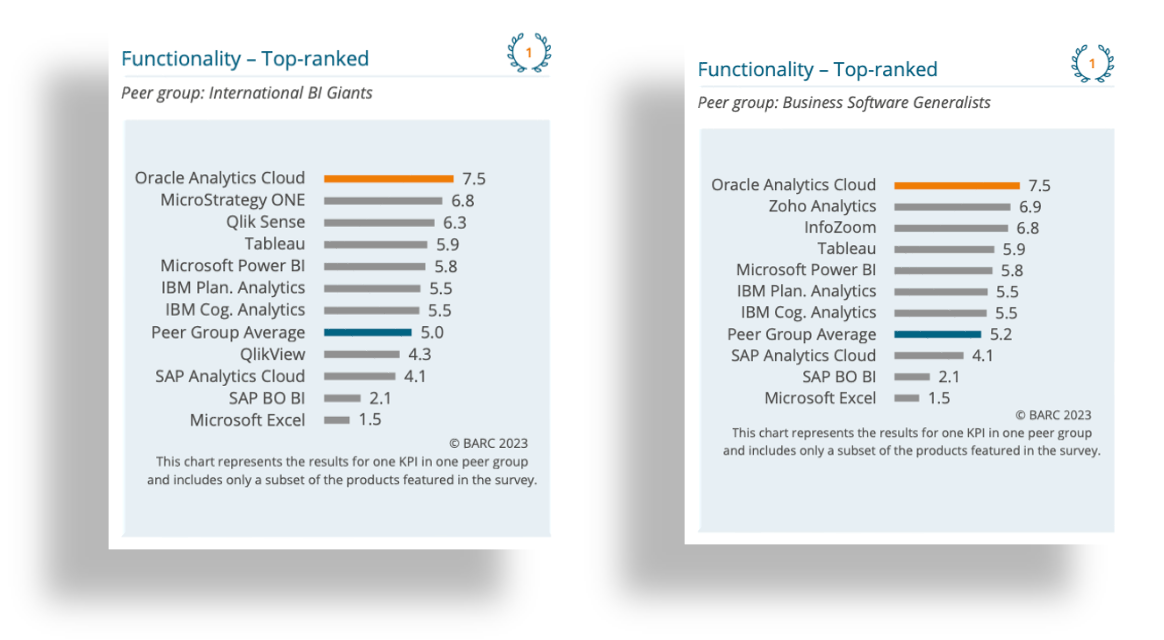
- Mobile BI
Based on how users rate the use of their BI tool on a mobile device, for product’s functionality for mobile business intelligence; it is not surprising to see 78 per cent of Oracle Analytics Cloud users expressing satisfaction with the tool’s functionality. Top rank is maintained for this KPI for International BI Giants, Business Software Generalists and Large/ Enterprise-Wide Implementations peer groups. Also strikingly, OAC is a Leader under Analysis Focus, Report & Dashboard Focus and Embedded Analytics Focus peer groups.
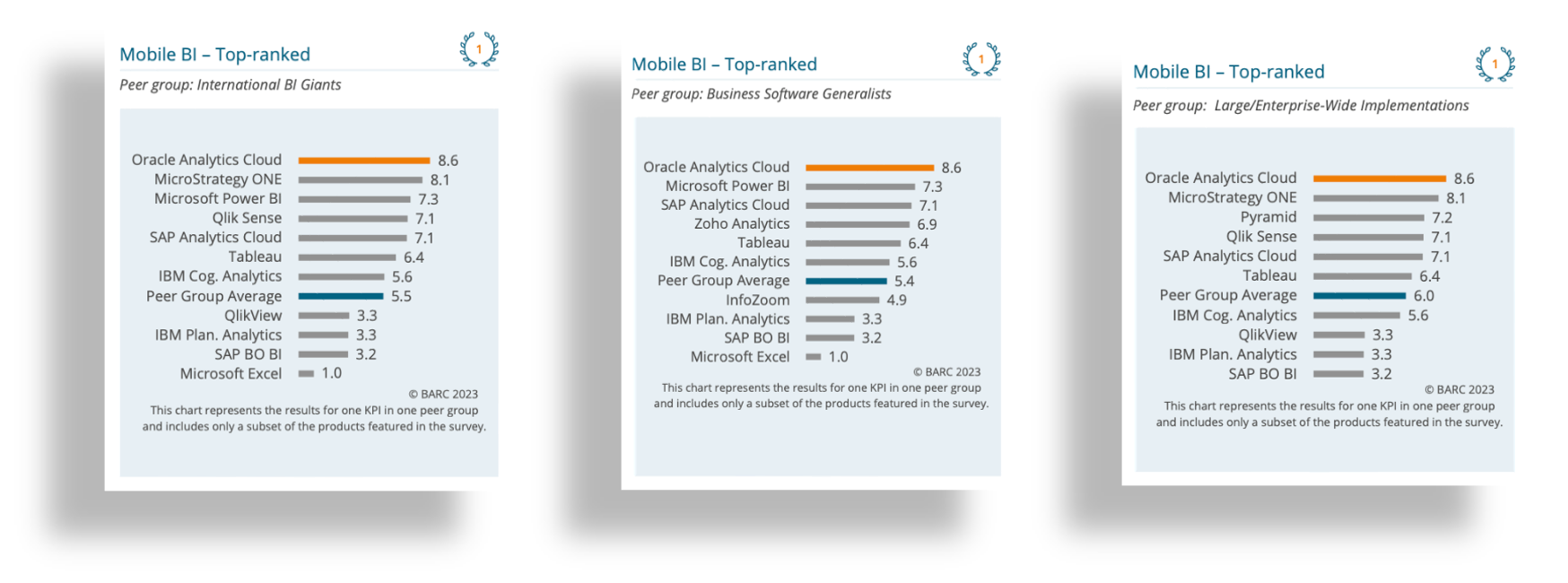
- Implementer Support
KPI measuring user satisfaction with the level of implementer’s support for the product is a key metric for business. Oracle Analytics Cloud is top-ranked in the peer group - International BI Giants and positioned as a Leader in Business Software Generalists and Large/Enterprise-Wide Implementations groups.
According to BARC, “82 per cent of Oracle Analytics Cloud respondents are satisfied with the Implementer Support provided while the remaining 18 per cent have not used any. 46 per cent even stated that the support they received from their implementer was “excellent”.
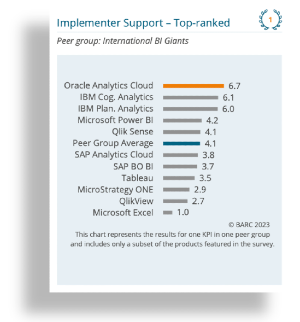
More KPI Highlights
A few other interesting KPIs where OAC is standing strong as a Leader are Competitive Win Rate, Cloud BI, User Experience, Performance Satisfaction, Ease of Use, Data Preparation, Analysis & Ad Hoc Query, Distribution of Reports, Customer Satisfaction, Recommendation and Business Benefits.
Some of the interesting OAC stats and extracts shared by BARC around these KPIs are highlighted below:
“Competitive Win Rate KPI that reflects the vendor’s percentage of wins in competitive evaluations has performed admirably with overall 56 per cent of Oracle Analytics customers engaged in competitive software selection process before opting for this product. A further 33 per cent evaluated Oracle only.”
“Cloud BI KPI measuring the proportion of customers using their BI solution in cloud environments showed that 55 per cent of the Oracle Analytics users surveyed stated that they have used the product in the cloud, and a further 36 per cent plan to do so in the future.”
According to BARC’s viewpoint, “While many of Oracle’s competitors are still struggling to bring their customers to the cloud, Oracle seems to have convinced a good portion of its customer base to modernise their analytics environments and benefit from a cloud deployment. Besides the ‘pure’ cloud option, Oracle also supports hybrid and on-premises scenarios for those who, for whatever reason, are not ready to move to the cloud. “
“The User Experience KPI combines the results of the Flexibility, Ease of Use and Performance Satisfaction KPIs. Oracle Analytics Cloud users rated the suite above average in each of these KPIs, resulting in a score of 7.5/10 for User Experience. Achievement under this KPI underlines the fact that Oracle Analytics Cloud is a versatile platform capable of serving different user types, not only for classic BI but also an increasing number of scenarios such as advanced analytics.”
“This year, the Ease of Use KPI provides insights into the perspectives of the data engineers from business departments, content creators and content consumers using Oracle Analytics Cloud. Remarkably, all the users surveyed expressed satisfaction with the product’s ease of use. 78 per cent rated the ease of use of its functionality for data modeling and preparation for business users as “excellent” or “good”. Content creators were even more appreciative, with 89 per cent rating ease of use as “excellent” or “good”. “
“A remarkable 91 per cent of Oracle respondents expressed their satisfaction with the functionality provided for wrangling and preparing data for analysis and reporting.”
“Impressively, 91 per cent of Oracle Analytics Cloud respondents expressed their satisfaction with the tool’s support for navigation, visual support, and automated insights as well as usability, the semantic model, and the ability to create ad hoc queries. The remaining 9 per cent were unable to rate this functionality, likely because they were end users who primarily utilise predefined content. “
“[…]Much like the previous year, customers highlighted several operational advantages that exceeded this year’s survey average. These benefits include ‘reduced costs,’ ‘improved customer satisfaction,’ ‘increased competitive advantage,’ ‘saved headcount,’ ‘improved operational efficiency’ and ‘increased revenues.’ In the categories of ‘saved headcount’ and ‘increased revenues,’ Oracle secured the third-best ranking in The BI & Analytics Survey 24, and it ranks fourth for ‘reduced costs’. This is a significant accomplishment, emphasising that BI and analytics doesn’t just help companies to visualise data but also has a tangible business impact.”
Summary
It will be interesting to see the sure rise of Oracle Analytics Cloud in the coming years, in line with the BARC report that clearly outlines the User and Use Case Demographics comparison for Current User Adoption vs Planned Use.
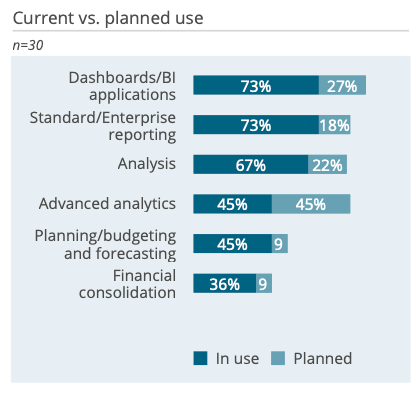
Collectively representing the voice of the BI and Analytics community, the golden mark made by Oracle Analytics Cloud is a testament to its powerful design, features and functionalities.